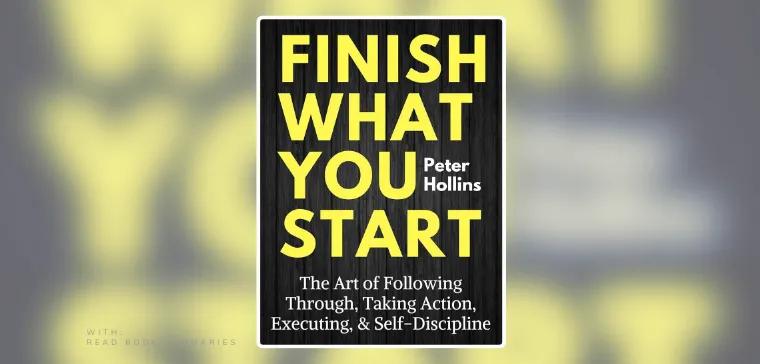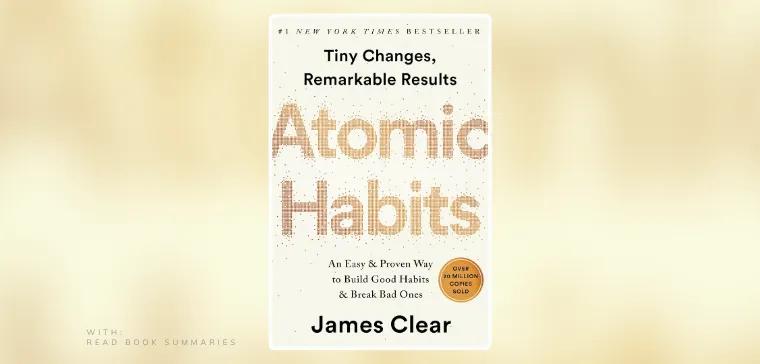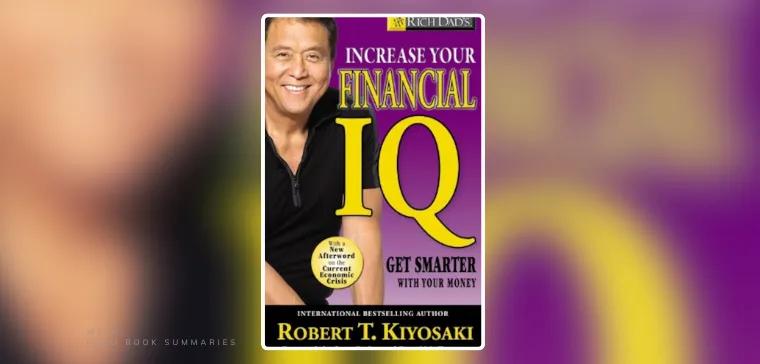

Unlocking the Secret to Unwavering Commitment: A Dive into "Finish What You Start"
Have you ever wondered why some people easily achieve their goals while others stumble at the first obstacle? "Finish What You Start: The Art of Following Through, Taking Action, Executing, & Self-Discipline" by Peter Hollins reveals the secret to turning your intentions into results. In our distraction-filled world, mastering the art of follow-through is more critical than ever.
"The art of following through is something that allows you to create the life that you actually want instead of settling for the life you currently have."
By exploring this summary, you'll uncover essential strategies to overcome procrastination and build strong self-discipline. Discover how Hollins' insights can revolutionize your approach to personal and professional challenges.
Prepare to dive into practical advice and psychological insights that promise to change the way you think about commitment and success. Keep reading to unlock the secrets of relentless execution and learn how to apply them to your life.
Introduction

In the introduction of "Finish What You Start," Peter Hollins emphasizes the critical importance of following through on our intentions. Hollins begins with a fundamental question: what does it truly mean to finish what you start? He explains that many people have good intentions but often fail to see them through due to distractions, fatigue, or boredom. This failure can leave projects abandoned and dreams unfulfilled, much like a half-carved wooden canoe left to gather dust in a garage.
The Concept of Follow-Through
Hollins introduces the concept of follow-through as a blend of focus, self-discipline, action, and persistence. Imagine a giant robot formed by smaller parts, where each part is crucial. Focus is the head, keeping your eyes on the prize. Self-discipline is the spine, supporting consistent effort. Action is the hands and feet, moving you forward. Persistence is the heart, keeping you going despite obstacles. This analogy helps visualize how these elements work together to achieve goals.
Overcoming Common Pitfalls
The author shares a personal story about his struggle to finish carving a wooden canoe, illustrating common pitfalls like procrastination and distraction. He introduces "temptation bundling," a strategy where you pair an obligatory task with a pleasurable activity to make it enjoyable. For example, Hollins listened to his favorite albums while working on his canoe, transforming the task into a more enjoyable experience. This approach shows how small mindset changes can significantly impact your ability to follow through.
In conclusion, the introduction sets the tone for the rest of the book by emphasizing the importance of understanding and overcoming barriers to follow-through. Hollins encourages readers to reflect on their unfinished projects and consider applying the principles of focus, self-discipline, action, and persistence to achieve their goals. This chapter invites readers to explore the book further to discover practical strategies for turning intentions into reality.
Chapter 1: Stop Thinking, Just Execute

In Chapter 1, Hollins stresses the importance of moving beyond planning and into action. He highlights that overthinking and excessive planning often lead to inaction.
The Importance of Execution
Hollins illustrates how people often get stuck in planning, overwhelmed by details and potential obstacles. He shares the story of Esther, who dreams of starting a baking business but never moves past planning due to fear and overthinking. This example shows how execution is the bridge between dreams and reality. Instead of waiting for the perfect moment, Hollins suggests taking immediate action. For instance, if you want to start a blog, write your first post today instead of spending weeks designing the perfect website.
Components of Follow-Through
The chapter breaks down follow-through into four essential components: focus, self-discipline, action, and persistence. Hollins likens these to parts of a robot, where each part is necessary for the whole to function. For example, if you're learning a new language, focus helps you prioritize study time, self-discipline keeps you practicing daily, action involves speaking and writing, and persistence ensures you continue even when progress seems slow.
In conclusion, Hollins encourages readers to stop overthinking and start executing. By understanding and applying the components of follow-through, individuals can overcome procrastination and achieve their goals. This chapter sets the foundation for the rest of the book, inviting readers to explore further strategies for effective execution and self-discipline.
Chapter 2: Staying Hungry

Chapter 2 focuses on maintaining motivation and drive to achieve your goals. Hollins explores the concept of staying "hungry" for success by understanding and using both internal and external motivators.
Understanding Motivation
Hollins divides motivation into two categories: external motivators and internal motivators. External motivators are influences from outside sources, like accountability partners or financial incentives. For example, if you want to lose weight, joining a fitness group can keep you accountable. Internal motivators are personal desires and goals, like wanting to feel healthier or more confident. These are often more powerful because they align with your personal values.
Balancing Costs and Benefits
The chapter also discusses opportunity cost, which is the idea that pursuing one goal often means sacrificing another. Hollins suggests ensuring that the benefits of achieving your goal outweigh the sacrifices. For instance, starting a business might mean giving up some leisure time, but the potential success and fulfillment should make the sacrifice worthwhile.
Hollins emphasizes keeping your motivations visible and tangible. He suggests using reminders, such as vision boards or daily affirmations, to keep your goals at the forefront of your mind.
In conclusion, staying hungry for success involves understanding what drives you and ensuring that your motivations are strong enough to overcome challenges. By balancing costs and benefits and keeping motivations visible, you can maintain the drive needed to follow through on your goals.
Chapter 3: Create a Manifesto

Chapter 3 focuses on creating a personal manifesto to guide daily actions and decisions. A manifesto is essentially a set of self-imposed rules that help streamline decision-making and enhance productivity by reducing reliance on willpower.
Establishing Personal Rules
Hollins emphasizes setting clear, actionable rules to eliminate indecision and procrastination. For instance, one rule might be to complete two tasks from your to-do list every day, no matter what. This ensures progress is made consistently, even on low-motivation days. Consider John, a writer who struggles to work after a long day. By adhering to his rule of writing two pages daily, he gradually completes his novel, avoiding the stress of unmet goals.
Reaffirming Intentions
Another key point is regularly reaffirming your intentions. Hollins suggests using statements like "I want," "I will," and "I won’t" to clarify goals and maintain focus. For example, if your goal is to improve fitness, you might say, "I want to be healthier, I will exercise three times a week, and I won’t skip workouts for trivial reasons."
In conclusion, creating a personal manifesto is about setting boundaries and guidelines that make following through on tasks more automatic. By establishing and sticking to these rules, you can reduce decision fatigue and increase your chances of success.
Chapter 4: Follow-Through Mindsets

Chapter 4 focuses on cultivating the right mindsets to enhance follow-through and achieve goals. Hollins emphasizes that following through is primarily a mental challenge, and adopting the right mindset can significantly impact persistence and success.
Mindset 1: It’s All Worthwhile
Believing in the value of your efforts is crucial. If you see your hard work as meaningful, you're more likely to stick with it. For example, a student who believes their studies will lead to a fulfilling career is more likely to persevere through difficult exams.
Mindset 2: Comfort with Discomfort
Becoming comfortable with discomfort is essential. Achieving significant goals often involves stepping out of your comfort zone. For instance, learning a new language might be uncomfortable at first but can lead to rewarding opportunities like traveling or working abroad.
Mindset 3: Allow Learning
Viewing every experience as a learning opportunity is important. This mindset encourages seeing failures as valuable lessons. For example, if a project doesn’t go as planned, analyzing what went wrong can improve future efforts.
Mindset 4: Managing Stress
Managing stress and anxiety is crucial for productivity. Hollins advises being aware of your emotional state and taking proactive measures to manage stress, like regular exercise or meditation.
In conclusion, adopting these mindsets can transform how you approach tasks and challenges, making it easier to follow through and achieve your objectives.
Chapter 5: The Science of Smashing Procrastination

Chapter 5 focuses on understanding and overcoming procrastination. Hollins delves into the psychological reasons behind procrastination and offers practical strategies to combat it.
Understanding Procrastination
Hollins explains that procrastination often results from time inconsistency, where our present self prioritizes immediate gratification over long-term rewards. This is like choosing a nap over working on a project because the nap offers instant comfort.
Strategies to Overcome Procrastination
One effective strategy is temptation bundling, which involves pairing a less enjoyable task with a pleasurable activity. For example, you might only listen to your favorite podcast while exercising. Another approach is starting tasks in small, manageable increments. Instead of writing an entire chapter, commit to writing one paragraph.
Hollins also suggests using productive paranoia—considering what could go wrong if you procrastinate. This fear of negative consequences can motivate you to take action.
In conclusion, by understanding the roots of procrastination and employing strategies like temptation bundling and starting small, you can effectively combat procrastination.
Chapter 6: No Distraction Zone

Chapter 6 focuses on creating an environment that minimizes distractions to enhance productivity and self-discipline. Hollins provides practical strategies to help maintain focus and avoid the pitfalls of a cluttered workspace.
Minimizing Distractions
Reducing distractions in your environment is crucial. For example, a cluttered desk can lead to a wandering mind. A clean workspace can help create a clear mind. Use the principle of "out of sight, out of mind" to keep distractions at bay.
Creating Default Actions
Create default actions that align with your goals. Make the desired actions the easiest ones to take. For example, if you want to exercise more, keep your workout clothes accessible. By designing your environment to make positive actions the default choice, you conserve willpower.
In conclusion, by minimizing distractions and creating environments that encourage positive default actions, you can enhance focus and productivity.
Chapter 7: Deadly Pitfalls

Chapter 7 focuses on identifying and avoiding common pitfalls that can derail progress and hinder goal achievement. Hollins outlines several key obstacles and provides strategies to overcome them.
Pitfall 1: Perfectionism
Perfectionism can paralyze progress. Perfectionists often delay tasks because they fear the outcome won't be flawless. Hollins suggests adopting a "good enough" mindset, focusing on progress rather than perfection.
Pitfall 2: Overcommitment
Overcommitment leads to burnout and decreased productivity. Hollins advises prioritizing tasks and learning to say no to commitments that do not align with primary goals.
Pitfall 3: Lack of Accountability
Without accountability, it's easy to procrastinate or abandon goals. Finding an accountability partner or joining a group with similar objectives can provide necessary support.
In conclusion, by recognizing and addressing these deadly pitfalls, individuals can enhance their ability to follow through and achieve their goals.
Chapter 8: Daily Systems for Success

Chapter 8 focuses on establishing daily systems to ensure consistent progress toward goals. Hollins emphasizes that while willpower and self-discipline are important, they are not always reliable. Structured systems can help maintain productivity even when motivation wanes.
The Importance of Systems
Systems are routines or sets of actions performed consistently to streamline success. Unlike goals, systems focus on process and consistency. For example, instead of setting a goal to write a book, a system would involve writing for 30 minutes every day.
Implementing Effective Systems
One key system is time management. Organizing your day and allocating specific times for tasks ensures important activities are prioritized. Another system is to lower transaction costs, making it easier to engage in productive behaviors and harder to indulge in unproductive ones.
In conclusion, by implementing daily systems, you can create a framework that supports consistent progress and reduces the need for constant motivation.
Chapter: Conclusion

In the conclusion of "Finish What You Start," Hollins encapsulates the essence of the book by emphasizing the importance of integrating the strategies discussed into daily life. The journey to achieving goals is about creating systems and mindsets that support consistent action.
Embracing Systems Over Goals
Focus on systems rather than goals. While goals set direction, systems keep you moving forward daily. For example, if your goal is to write a book, the system would involve writing a set number of words each day.
Cultivating the Right Mindset
Adopt a growth mindset. View challenges as opportunities for learning rather than obstacles. For instance, if you encounter a setback in your project, consider it a chance to refine your approach.
In summary, Hollins urges readers to apply the principles of focus, self-discipline, action, and persistence in their daily lives. By doing so, they can transform intentions into reality and achieve the life they desire. The book concludes with a call to action, encouraging readers to take the first step toward implementing these strategies.
Conclusion

As we wrap up our exploration of "Finish What You Start," it's clear that the journey from intention to execution is paved with focus, self-discipline, action, and persistence. These elements form the backbone of following through, helping us transform our dreams into reality.
Reflecting on the book, its impact is profound. It challenges us to confront our inhibiting tactics and psychological roadblocks, offering practical strategies to overcome them. By adopting daily systems and cultivating the right mindsets, we can enhance our productivity and achieve our goals.
"The art of following through is something that allows you to create the life that you actually want instead of settling for the life you currently have."
To apply these teachings, start by setting small, manageable goals and creating a system that supports consistent progress. Consider using temptation bundling to make tasks more enjoyable and keep distractions at bay.
What steps can you take today to ensure you follow through on your most important goals?
Dive deeper into Hollins' insights and discover how you can transform your approach to achieving success. Whether you choose to read the book or implement its strategies, the path to a more disciplined and fulfilling life awaits.



